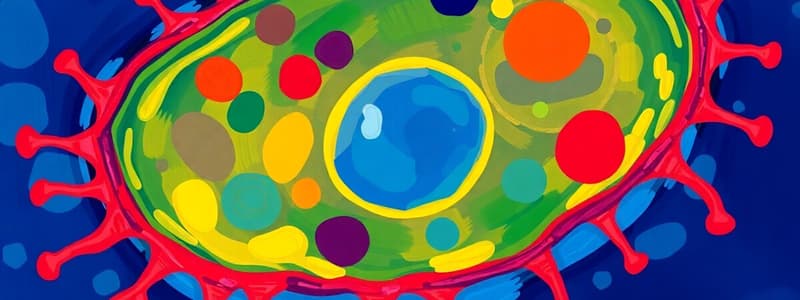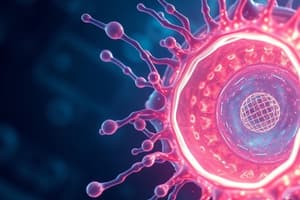Podcast
Questions and Answers
Which of the following cellular components are found in both prokaryotic and eukaryotic cells?
Which of the following cellular components are found in both prokaryotic and eukaryotic cells?
- Mitochondria
- Plasma membrane, cytoplasm, DNA, and ribosomes (correct)
- Endoplasmic reticulum
- Nucleus
The primary cell wall, present in plant cells, provides rigidity due to its high lignin content.
The primary cell wall, present in plant cells, provides rigidity due to its high lignin content.
False (B)
What is the main function of mitochondria within a cell?
What is the main function of mitochondria within a cell?
to produce energy through cellular respiration
__________ junctions form a continuous seal between cells, preventing leakage of fluids.
__________ junctions form a continuous seal between cells, preventing leakage of fluids.
Match each type of cell membrane protein with its primary function:
Match each type of cell membrane protein with its primary function:
A cell is placed in a solution, and water begins to move into the cell. Which type of transport is most likely occurring?
A cell is placed in a solution, and water begins to move into the cell. Which type of transport is most likely occurring?
Enzymes are consumed during a reaction, which is why they are needed in large amounts.
Enzymes are consumed during a reaction, which is why they are needed in large amounts.
Describe the function of the Golgi apparatus in a cell.
Describe the function of the Golgi apparatus in a cell.
________ is the process where cells release large molecules by merging a vesicle with the cell membrane.
________ is the process where cells release large molecules by merging a vesicle with the cell membrane.
Which of the following best describes the role of microfilaments within a cell?
Which of the following best describes the role of microfilaments within a cell?
Flashcards
Prokaryotes
Prokaryotes
Smaller, simpler cells that lack a nucleus.
Eukaryotes
Eukaryotes
More complex, larger cells that possess a nucleus.
Phospholipid Bilayer
Phospholipid Bilayer
A double layer of phospholipid molecules with hydrophilic heads facing outward and hydrophobic tails facing inward.
Integral Proteins
Integral Proteins
Signup and view all the flashcards
Nucleus
Nucleus
Signup and view all the flashcards
Mitochondria
Mitochondria
Signup and view all the flashcards
Endoplasmic Reticulum (ER)
Endoplasmic Reticulum (ER)
Signup and view all the flashcards
Cell Membrane
Cell Membrane
Signup and view all the flashcards
Tight Junctions
Tight Junctions
Signup and view all the flashcards
Diffusion
Diffusion
Signup and view all the flashcards
Study Notes
- Key components for all cells: plasma membrane, cytoplasm, DNA, and ribosomes.
Eukaryotic vs Prokaryotic Cells:
- Prokaryotes are smaller, simpler, and lack a nucleus.
- Eukaryotes are more complex, larger, and possess a nucleus.
Cell Membrane:
- The cell membrane is a phospholipid bilayer with hydrophilic heads facing outward and hydrophobic tails facing inward.
- The membrane selectively regulates the entry and exit of substances.
Cell Membrane Proteins:
- Integral proteins facilitate molecule movement in and out of the cell.
- Peripheral proteins aid in communication, cell shape, and speed up reactions.
- Channel proteins allow specific molecules to pass through without energy.
- Carrier proteins transport molecules in or out, sometimes using energy.
- Receptor proteins receive signals and trigger responses.
- Glycoproteins help cells recognize each other and participate in the immune system.
Cell Walls:
- Primary cell wall is the first layer in plant cells, enabling growth and flexibility.
- It has a primary cellulose composition.
- Secondary cell wall develops inside the primary wall in some plant cells.
- Lignin is an example of a component that increases rigidity.
- Middle lamella is a pectin layer that connects adjacent plant cells.
- Gram-positive bacteria have a thick peptidoglycan layer.
- Gram-negative bacteria have a thinner peptidoglycan layer plus an outer membrane.
Organelles & Functions:
- Organelles are specialized structures with specific functions within a cell.
- Nucleus stores DNA and coordinates cellular activities related to growth and reproduction.
- It is considered the "brain" of the cell.
- Mitochondria produces energy through cellular respiration.
- Ribosomes are responsible for protein synthesis.
- Endoplasmic Reticulum (ER) is a network of membranes involved in protein and lipid synthesis.
- Rough ER has ribosomes attached, while Smooth ER does not.
- Golgi Apparatus modifies, sorts, and packages proteins for secretion.
- Lysosomes contain digestive enzymes that break down waste and worn-out cell parts.
- Vacuoles store water, nutrients, and waste, and are prominent in plant cells.
- Cell Membrane separates the cell from its environment, controlling what enters and exits.
- Cytoplasm is the jelly-like substance where cellular processes occur.
- Centrioles organize microtubules during mitosis for cell division.
- Ribosomes are found in mitochondria and chloroplasts.
Cell Junctions:
- Tight junctions form a continuous seal to prevent leakage in tissues.
- Adherens junctions provide strong cell-to-cell adhesion, important for tissues under mechanical stress.
- Desmosomes are specialized adherens junctions for strong connections, especially in tissues with high tensile strength like the epidermis.
- Gap junctions create channels for direct exchange of ions and small molecules, crucial for rapid communication.
Cytoskeleton:
- Microfilaments (actin filaments) aid in cell movement, shape, and division.
- They are important for muscle contraction.
- Intermediate filaments provide strength and stability, helping cells resist stress.
- Microtubules act as tracks for moving things and are important for cell division, most notably chromosome separation.
Energy - Kinetic vs Potential:
- Potential energy is stored energy due to an object's position or condition.
- Kinetic energy is the energy an object has because it's moving.
- Potential energy is stored and kinetic energy is in motion.
- Electrons carry energy when they move, which is how electricity is transferred.
- Oxidation is losing electrons.
- Reduction is gaining electrons.
- ATP (adenosine triphosphate) is the main energy source for cells, storing energy in the bond between the second and third phosphate groups.
- When a cell needs energy, it breaks off the third phosphate group, converting ATP to ADP (adenosine diphosphate).
- ATP is like a charged battery that releases energy when it loses a phosphate.*
- The sun is a source of energy.
Photosynthesis and Cellular Respiration:
- Photosynthesis makes glucose and oxygen.
- Respiration uses glucose and oxygen to release energy.
- Carbon dioxide produced by respiration is used in photosynthesis.
- Materials for photosynthesis are carbon dioxide, water, and light energy.
- Materials for respiration are glucose and oxygen.
Enzymes
- Enzymes are proteins made of amino acids
- The active site is the part of the enzyme where the substrate binds.
- It is like a "lock" and the substrate is the "key".
- Enzymes speed up reactions by lowering the needed energy.
- The active site is where the enzyme works.
- Competitive inhibition blocks the active site.
- Non-competitive inhibition changes the enzyme shape.
Cell Transport:
- Diffusion involves molecules moving from high to low concentration without energy.
- Osmosis involves water moving through a membrane from low to high solute concentration without energy.
- Active transport involves molecules moving against the concentration gradient, requiring energy (ATP).
- Endocytosis is when the cell takes in large molecules by engulfing them, and requires energy.
- Exocytosis is when the cell releases large molecules by merging a vesicle with the membrane.
- It requires energy.
Studying That Suits You
Use AI to generate personalized quizzes and flashcards to suit your learning preferences.




